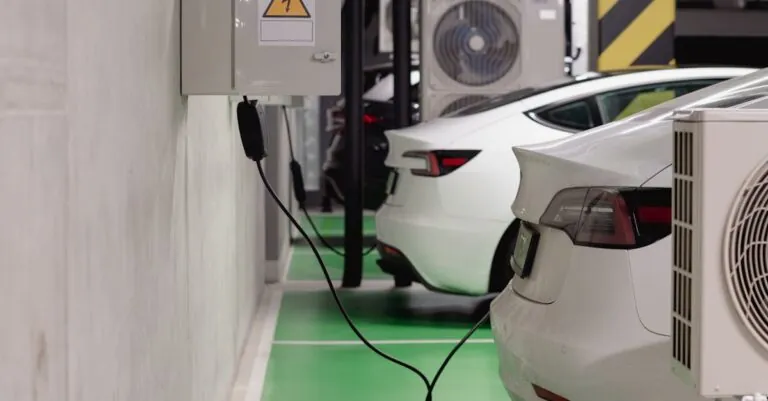Table of Contents
ToggleElectric cars are the future, but let’s face it—range anxiety can feel like that awkward moment when you realize you’ve forgotten your wallet at dinner. What really affects how far these silent wonders can go? It’s not just about battery size or that flashy new model everyone’s buzzing about. Factors like driving habits, terrain, and even the weather play a role in determining how far one can travel on a single charge.
Understanding these elements can save drivers from the dreaded “Are we there yet?” moments. So buckle up as we dive into the nitty-gritty of electric car range, exploring what keeps those wheels rolling and how to maximize every precious mile. Whether it’s a quick jaunt to the grocery store or a cross-country adventure, knowing what influences range can make all the difference in enjoying the ride.
Understanding Electric Car Range
Electric car range refers to the distance an electric vehicle (EV) can travel on a single charge. This range is affected by multiple factors beyond battery capacity.
Driving habits significantly impact range. Aggressive acceleration and high speeds can deplete battery life quickly, while smooth driving at moderate speeds conserves energy.
Terrain plays a critical role as well. Hilly landscapes require additional energy, while flat roads facilitate longer trips.
Weather conditions also influence distance. Cold temperatures can reduce battery efficiency, while hot weather can result in increased energy use for climate control.
Accessory usage affects range too. Utilizing air conditioning or heating systems consumes battery power, which may further reduce travel distance.
Vehicle weight can’t be overlooked. Heavier loads demand more energy, thus lowering the effective range.
Tire pressure is another component to keep in mind. Low tire pressure increases rolling resistance, which can negatively impact distance.
Charging habits contribute to range management. Frequent charging can keep an EV’s battery topped off, providing drivers with additional flexibility.
Lastly, initial battery condition matters. Older batteries may not hold a charge as effectively as new ones, resulting in reduced range.
To maximize electric car range, drivers should consider these factors. Understanding how to manage driving style, weather, and vehicle maintenance can lead to enhanced performance and reduced anxiety on the road.
Key Factors Influencing Range
Multiple factors impact the electric car range, beyond just battery specifications. Understanding these elements can enhance driving efficiency and minimize range anxiety.
Battery Capacity
Battery capacity plays a significant role in determining how far an electric vehicle can travel. Measured in kilowatt-hours (kWh), a higher capacity generally provides a greater range. For instance, vehicles with 60 kWh batteries often reach about 200 miles on a single charge. Larger batteries, like those with 100 kWh, can enable ranges of up to 300 miles or more. However, battery age and state of charge can also reduce effective capacity, impacting the overall distance.
Vehicle Weight
Vehicle weight directly affects energy consumption and range. Heavier vehicles require more energy to accelerate and maintain speed. A difference of 100 pounds may decrease range by 1-2% depending on the vehicle’s efficiency. Lightweight materials in the design, such as aluminum or composite bodies, can enhance efficiency, allowing for greater distances on a single charge. Drivers should consider carrying only necessary items to optimize their range.
Aerodynamics
Aerodynamics significantly influences how efficiently an electric car navigates air resistance. Streamlined designs reduce drag, allowing vehicles to use energy more effectively. For example, an aerodynamic shape can increase range by up to 10-15% compared to less efficient models. Features like smooth underbodies and rounded edges improve airflow. Adjusting driving speeds also affects aerodynamics; maintaining a steady speed can maximize range by minimizing turbulent air resistance.
Environmental Impacts
Environmental factors significantly influence electric car range. Temperature and terrain each play crucial roles in determining how far an electric vehicle can travel on a single charge.
Temperature Effects
Cold weather adversely affects battery performance. When temperatures drop below 32°F (0°C), battery capacity can decrease by up to 40%. This reduction directly impacts the vehicle range, as drivers may notice a shorter distance before needing to recharge. High temperatures can also pose challenges; they may lead to increased energy use for air conditioning, further diminishing overall efficiency. Maintaining battery temperature within the ideal range can enhance performance and extend driving distance.
Terrain Considerations
Terrain has a marked impact on energy consumption. Driving uphill requires more energy, reducing range considerably on hilly routes. Every elevation gain demands increased battery power, as the vehicle must work harder against gravity. Conversely, flat terrains generally allow for improved efficiency, enabling longer trips before recharging. Understanding the terrain can help drivers plan routes effectively and manage energy use, maximizing the electric car’s range in varying conditions.
Driving Behavior
Driving behavior significantly influences electric car range. Understanding how different habits affect efficiency helps maximize distance on a single charge.
Acceleration Patterns
Rapid acceleration consumes more energy compared to gradual increases in speed. Drivers accelerating smoothly can extend their electric vehicle’s range by saving battery power. Frequent hard braking also leads to energy loss. Regenerative braking techniques allow energy recovery during deceleration, enhancing overall efficiency. Thus, consistent driving at moderate speeds on highways can prove beneficial, using less power over time. By adjusting acceleration patterns, drivers can achieve a more efficient driving experience.
Use of Climate Control
Climate control systems impact electric vehicle energy consumption. Heating and cooling the cabin requires additional power, often reducing driving range. In fact, using air conditioning can decrease range by up to 20%. When possible, drivers should prioritize pre-conditioning their vehicle while it’s still plugged in, thus utilizing grid power instead of battery energy. Utilizing seat heaters rather than cabin heating can also conserve energy. Adjusting climate settings judiciously further enhances range, making it essential to consider these factors during longer trips.
Technological Advances
Technological advancements play a critical role in enhancing electric vehicle range. Innovations in battery technology and energy management significantly affect performance.
Efficiency Improvements
New battery chemistries, such as solid-state batteries, offer higher energy density. Greater energy density contributes to increased range without a corresponding weight increase. Regenerative braking systems have also evolved, allowing for more efficient energy recovery during deceleration. Improved thermal management systems optimize battery temperature, ensuring better efficiency and longevity. Enhanced aerodynamics from vehicle redesigns reduce drag, leading to better range outcomes. Weight reduction techniques using lightweight materials further increase range by decreasing energy requirements.
Future Trends
Looking ahead, further advancements in battery technology promise significant range improvements. Researchers are exploring new materials that could double current battery capacities. Wireless charging infrastructure is another emerging trend, potentially eliminating range anxiety due to convenient charging options. Autonomous driving technology may also enhance efficiency by optimizing driving patterns. Integration of artificial intelligence into energy management systems will allow real-time adjustments based on driving conditions. All these innovations collectively push the boundaries of electric vehicle capabilities, ensuring longer and more efficient drives.
Understanding what affects electric car range is essential for maximizing the driving experience. Factors like driving habits terrain and weather can significantly influence how far an EV can go on a single charge. By adopting efficient driving techniques and being mindful of environmental conditions drivers can enhance their vehicle’s performance.
Technological advancements in battery design and energy management are paving the way for improved range capabilities. As the industry evolves innovations will continue to address range anxiety and enhance the practicality of electric vehicles. Embracing these insights will empower drivers to make informed decisions and enjoy the benefits of electric mobility.







